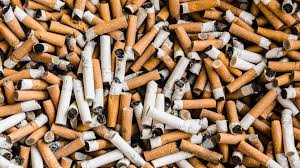Almost everyone knows that tobacco smoking is dangerous to health.
“However, what many do not know are the dangers that disposing cigarette butts or filters pose to their environment,” according to an expert, Mr Alexander Akhigbe.
Akhigbe, Chief Environmental Officer, African Clean Up Initiative, an NGO, made the statement on Thursday in Lagos as the world marked the 2018 World No Tobacco Day (WNTD).
WNTD is marked annually on May 31 and the theme for 2018 is: “Tobacco and Heart Disease.”
This year’s activities aim to increase awareness on feasible actions and measures that key audiences, including government and the public , can take to reduce the risks to heart health posed by tobacco.
Akhigbe said tobacco waste, including cigarette butts, contained over 7,000 dangerous chemicals.
According to him, some of such chemicals include arsenic, formaldehyde, lead, nicotine and ethyl phenol.
Aarsenic is a chemical used for killing rats while formaldehyde is used to preserve dead animals and humans.
He said that more than five trillion cigarettes were smoked worldwide each year and all disposed one way or another without thought of its dangers to the environment.
“They are dropped on the ground, tossed in trash bins and disposed in landfills with little or no thought given by the smoker or society of what that means to the environment. Each of these components of discarded cigarette butts, which include un-smoked remnant of tobacco, the filter and the wrap presents its own concerns,” he said.
Akhigbe said that a health and environment website, Keep America Beautiful (KAB), says only 10 per cent of cigarette butts are properly deposited in ash receptacles.
“A survey of more than 1,000 smokers found that 35 per cent of smokers toss five or more cigarette butts per pack on the ground, overlooking the consequences,” the website said.
He said that littered cigarette butts leached toxic chemicals into the environment and contaminated water.
“The toxic exposure can poison fish, as well as animals who eat cigarette butts. Hazardous substances have been identified in cigarette butts, including arsenic, lead, nicotine and ethyl phenol.
“Very Well Mind (VWM), another health website, reveals that the core of most cigarette filters, the part that looks like white cotton, is a form of plastic called cellulose acetate.
“Cellulose acetate is very slow to degrade in the environment and depending on the area it is discarded in, it can take 18 months to 10 years for a cigarette filter to decompose,” he said.
On solutions and proper ways to dispose tobacco wastes and cigarette butts, he said: “The recycling of tobacco wastes as a way of proper disposal is recommended.
“The collected wastes will be shredded and separated while the plastic, the cigarette filters, will undergo pelletisation and extrusim to be molded into various cycled plastic products. The ash can then be used in fertilisers while the cigarette butts are recycled into industrial products like plastic pallets,” Akhigbe said.
According to the World Health Organisation, tobacco use is the second leading cause of cardiovascular diseases (CVDs), after high blood pressure.
“CVDs kill more people than any other cause of death worldwide. Tobacco use and second-hand smoke exposure contribute to approximately 12 per cent of all heart disease deaths,” the world health body said.
Apart from the damage to the lungs and heart, tobacco use could also cause damage to other organs including the eyes, skin, uterus, cervix and scrotum. (NAN)


